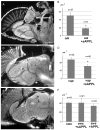Amyloid precursor proteins are protective in Drosophila models of progressive neurodegeneration
- PMID: 22266106
- PMCID: PMC4073673
- DOI: 10.1016/j.nbd.2011.12.047
Amyloid precursor proteins are protective in Drosophila models of progressive neurodegeneration
Abstract
The processing of Amyloid Precursor Proteins (APPs) results in several fragments, including soluble N-terminal ectodomains (sAPPs) and C-terminal intracellular domains (AICD). sAPPs have been ascribed neurotrophic or neuroprotective functions in cell culture, although β-cleaved sAPPs can have deleterious effects and trigger neuronal cell death. Here we describe a neuroproprotective function of APP and fly APPL (Amyloid Precursor Protein-like) in vivo in several Drosophila mutants with progressive neurodegeneration. We show that expression of the N-terminal ectodomain is sufficient to suppress the progressive degeneration in these mutants and that the secretion of the ectodomain is required for this function. In addition, a protective effect is achieved by expressing kuzbanian (which has α-secretase activity) whereas expression of fly and human BACE aggravates the phenotypes, suggesting that the protective function is specifically mediated by the α-cleaved ectodomain. Furthermore, genetic and molecular studies suggest that the N-terminal fragments interact with full-length APPL activating a downstream signaling pathway via the AICD. Because we show protective effects in mutants that affect different genes (AMP-activated protein kinase, MAP1b, rasGAP), we propose that the protective effect is not due to a genetic interaction between APPL and these genes but a more general aspect of APP proteins. The result that APP proteins and specifically their soluble α-cleaved ectodomains can protect against progressive neurodegeneration in vivo provides support for the hypothesis that a disruption of the physiological function of APP could play a role in the pathogenesis of Alzheimer's Disease.
Copyright © 2012 Elsevier Inc. All rights reserved.
Figures






References
-
- Araki W, Kitaguchi N, Tokushima Y, Ishii K, Aratake H, Shimohama S, Nakamura S, Kimura J. Trophic effect of beta-amyloid precursor protein on cerebral cortical neurons in culture. Biochem Biophys Res Commun. 1991;181:265–271. - PubMed
-
- Beher D, Hesse L, Masters CL, Multhaup G. Regulation of amyloid protein precursor (APP) binding to collagen and mapping of the binding sites on APP and collagen type I. J Biol Chem. 1996;271:1613–1620. - PubMed
-
- Bell KF, Zheng L, Fahrenholz F, Cuello AC. ADAM-10 over-expression increases cortical synaptogenesis. Neurobiol Aging. 2008;29:554–565. - PubMed
MeSH terms
Substances
Grants and funding
LinkOut - more resources
Full Text Sources
Medical
Molecular Biology Databases

